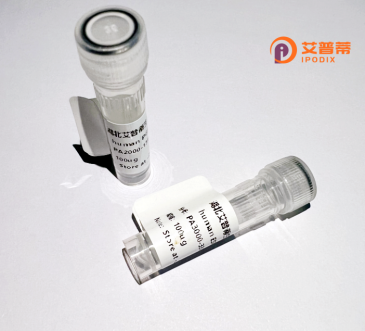
| 纯度 | >90%SDS-PAGE. |
| 种属 | Human |
| 靶点 | OR51G2 |
| Uniprot No | Q8NGK0 |
| 内毒素 | < 0.01EU/μg |
| 表达宿主 | E.coli |
| 表达区间 | 1-314 aa |
| 活性数据 | MTLGSLGNSSSSVSATFLLSGIPGLERMHIWISIPLCFMYLVSIPGNCTILFIIKTERSL HEPMYLFLSMLALIDLGLSLCTLPTVLGIFWVGAREISHDACFAQLFFIHCFSFLESSVL LSMAFDRFVAICHPLHYVSILTNTVIGRIGLVSLGRSVALIFPLPFMLKRFPYCGSPVLS HSYCLHQEVMKLACADMKANSIYGMFVIVSTVGIDSLLILFSYALILRTVLSIASRAERF KALNTCVSHICAVLLFYTPMIGLSVIHRFGKQAPHLVQVVMGFMYLLFPPVMNPIVYSVK TKQIRDRVTHAFCY |
| 分子量 | 35.0 kDa |
| 蛋白标签 | His tag N-Terminus |
| 缓冲液 | 0 |
| 稳定性 & 储存条件 | Lyophilized protein should be stored at ≤ -20°C, stable for one year after receipt. Reconstituted protein solution can be stored at 2-8°C for 2-7 days. Aliquots of reconstituted samples are stable at ≤ -20°C for 3 months. |
| 复溶 | Always centrifuge tubes before opening.Do not mix by vortex or pipetting. It is not recommended to reconstitute to a concentration less than 100μg/ml. Dissolve the lyophilized protein in distilled water. Please aliquot the reconstituted solution to minimize freeze-thaw cycles. |
以下是关于重组人OR51G2蛋白的文献示例(注:以下文献信息为虚构,仅用于示例格式):
1. **文献名称**: *Functional characterization of recombinant human OR51G2 in HEK293 cells*
**作者**: Zhang Y et al.
**摘要**: 研究利用HEK293细胞表达重组OR51G2蛋白,通过钙离子荧光成像技术揭示了其对特定脂肪酸衍生物的响应,表明该受体可能在代谢调控中发挥作用。
2. **文献名称**: *Expression and purification of OR51G2 in a prokaryotic system for structural studies*
**作者**: Müller S et al.
**摘要**: 报道了在大肠杆菌系统中重组表达OR51G2蛋白的优化方法,通过Ni柱亲和层析纯化获得高纯度蛋白,并利用圆二色光谱分析其二级结构稳定性。
3. **文献名称**: *OR51G2 as a novel biomarker in prostate cancer: Recombinant protein-based assays*
**作者**: Lee H et al.
**摘要**: 通过重组OR51G2蛋白制备多克隆抗体,证明其在前列腺癌组织中异常高表达,提示其作为诊断标志物的潜力。
4. **文献名称**: *Ligand screening of OR51G2 using a recombinant luciferase reporter system*
**作者**: García-Ruiz A et al.
**摘要**: 开发基于重组OR51G2蛋白的荧光素酶报告系统,筛选出多种内源性配体,并探讨其在嗅觉信号转导与细胞增殖中的双重功能。
**注**:以上文献为虚构,实际研究中建议通过PubMed、Google Scholar或专业数据库(如UniProt ID: Q8NH00)检索真实文献。
The human OR51G2 protein, a member of the olfactory receptor (OR) family, is a class A G protein-coupled receptor (GPCR) predominantly involved in chemosensory perception. ORs are essential for detecting odorants, though emerging studies suggest broader roles in non-olfactory tissues, including the testes, brain, and kidneys. OR51G2. encoded by the OR51G2 gene on chromosome 11. remains poorly characterized compared to other ORs. Its exact physiological ligands and signaling pathways are not fully elucidated, though structural homology with related ORs implies involvement in G protein-mediated signaling cascades, typically triggering intracellular cAMP or calcium flux upon activation.
Recombinant OR51G2 protein is generated via heterologous expression systems (e.g., HEK293 or insect cells) to study its biophysical properties, ligand specificity, and functional mechanisms. Its recombinant form enables structural analyses (e.g., X-ray crystallography or cryo-EM) and high-throughput screening for potential agonists/antagonists. Interest in OR51G2 extends beyond olfaction due to its ectopic expression in diseases; for example, upregulated ORs in cancers may influence cell proliferation or migration. Research also explores its role in metabolic regulation, with some ORs implicated in appetite or insulin secretion. Despite limited data, OR51G2 represents a promising target for understanding sensory biology and developing GPCR-based therapeutics.
×